Resources to Teach
> Kimiashida
> Oral Genres
What makes a good teacher great?
Teaching speaking skills 1. While it is a bit of an exaggeration, students clearly feel that classroom-based speaking practice does not prepare them for the real world. Why do students so often highlight listening and speaking as their biggest problems? Partly because of the demands of listening and speaking and partly because of the way speaking is often taught. It usually consists of language practice activities (discussions, information-gap activities etc.) or is used to practise a specific grammar point.
Find the gap - increasing speaking in class. This article looks at how the notion of a gap between speakers can be used to provide a reason for communication.
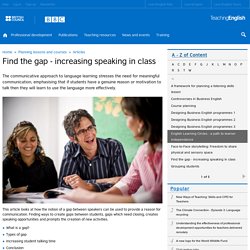
Finding ways to create gaps between students, gaps which need closing, creates speaking opportunities and prompts the creation of new activities. What is a gap? Types of gap Increasing student talking time Conclusion. 4 ways to help hesitant students to speak in the classroom « Oxford University Press – English Language Teaching – Global Blog. Speaking is one of the hardest skills for a language learner to master.

In this post, Verissimo Toste, an Oxford teacher trainer, shares four simple tips to help get even the most hesitant students speaking in class. Getting students to speak in class may be the most difficult task many teachers face. I remember a group of adult pre-intermediate students, all of whom had previously studied at least 6 years of English. They had little difficulty with the grammar exercises or the vocabulary. Reading texts were easy and although they were nervous about listening, it presented little difficulty.
BNCC EI EF 110518 versaofinal site. Vista do Documentos oficiais e o inglês no ensino médio brasileiro: um breve histórico. Gêneros Orais Conceituação e Caracterização. Generic, Discourse, and Lexicogrammatical Characteristics of a Listening Exercise in an EFL Classroom. Teaching ESL EFL. ED495377. Teaching Speaking and Listening in the Primary School 3rd ed by Elizabeth Grugeon Lyn Dawes Carol Smith and Lorraine Hubbard z lib.
BROWN Teaching by Principles An Interactive Approach to Language Pedagogy 331 361. BROWN Teaching by Principles An Interactive Approach to Language Pedagogy 362 405. Increasing EFL Learners Oral Production at a Public School Through Project-Based Learning. Increasing EFL Learners' Oral Production at a Public School Through Project-Based Learning Incremento de la producción oral de aprendices de inglés como lengua extranjera en una escuela pública mediante el aprendizaje basado en proyectos Ady Marcela Vaca Torres* Colegio Virginia Gutiérrez de Pineda, Bogotá, Colombia Luis Fernando Gómez Rodríguez** Universidad Pedagógica Nacional de Colombia, Bogotá, Colombia *adymarcela@hotmail.com **lfgomez@pedagogica.edu.co.
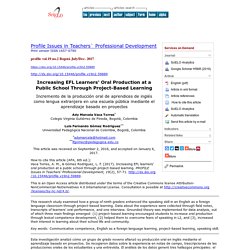
Using a genre-based approach to promote oral communication in the colombian english classroom. Using a genre-based approach to promote oral communication in the colombian english classroom El uso de un enfoque de generos textuales para promoverla comunicación oral en las aulas de inglés en Colombia Jose David Herazo Rivera* Universidad de Cordoba Montería-Colombia E-mail: jherazo4@gmail.com *Jose David Herazo, is a full time teacher at Universidad de Córdoba (Montería, Colombia), where he works as a pre-service teacher trainer in the English as a Foreign Language department.

Promoting Listening Fluency in Pre-Intermediate EFL Learners Through Meaningful Oral Tasks. Teaching Speaking: Activities to Promote Speaking in a Second Language. The Internet TESL Journal Hayriye of Nevada (Nevada,USA) Introduction Speaking is "the process of building and sharing meaning through the use of verbal and non-verbal symbols, in a variety of contexts" (Chaney, 1998, p. 13).
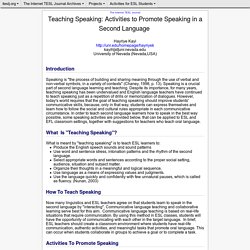
Video-Mediated Listening and Multiliteracies. This research study is framed in a qualitative approach which seeks to describe and analyze problems or situations at a much-focalized point.
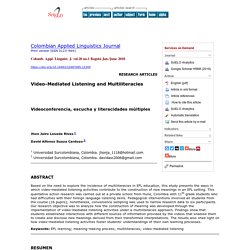
According to Hernández-Sampieri, Fernández, and Baptista (2014) , the importance of this research approach is that its foundations are centered on interpretations of a reality or realities lived by the participants, with the possibility of being redefined according to their needs. In order to achieve the expectations set through the research question and the objectives, the type of study chosen was action research, which follows a cyclical process involving (a) planning, (b) acting, (c) observing, and (d) reflecting (Burns, 2015). In this regard, this type of research is merely pedagogical and by using it, we had the opportunity to empower our regular practices by making sense of our daily interaction with students to adjust our teaching and create an appropriate learning environment.
12 Verbal Literacy Games for Speaking, Listening & Thinking. 12 Fun Speaking Games for Language Learners. When working with world language classes or English language learners, have you ever asked a question only to be answered with complete silence and blank stares?

It’s a common issue—nearly every teacher has struggled with encouraging students to speak in a language they’re still learning. A student may have a deep fear of making a mistake, or may be just plain shy, even in their native language.
10 ESL Speaking & Listening Games. Games and fun activities are a vital part of teaching English as a foreign language. Whether you’re teaching adults or children, games will liven up your lesson and ensure that your students will leave the classroom wanting more.
Games can be used to warm up the class before your lesson begins, during the lesson to give students a break when you’re tackling a tough subject, or at the end of class when you have a few minutes left to kill. There are literally hundreds, probably thousands, of games that you can play with your students.
25 ESL Listening Activities for Every Learning Style. What’s your style?

Do you like to move and groove? Do you just listen to the music? Do you like to partner up? No, I’m not talking about party personalities.
ESL Listening Activities, Games, Worksheets, and Lesson Plans. If you’re looking for some of the best ESL listening activities and games, then you’re certainly in the right place.

Keep on reading for some of the best ELL listening activities, along with tips and tricks for English learners to improve their listening skills. ELL listening activities ESL Listening Activities and Games Do you want to improve your English listening?
Kids and speaking. A reason to speak Make sure that the children have a reason for speaking, for example, they need to talk to their partner to complete a picture or to find information in order to make a graph.
Think about the questions you ask in class. If you ask ‘Is this a pencil?’
Middle School Listening Activities. Source The National Capital Language Resource Center explains that effective listening incorporates the ability to comprehend spoken words and separate relevant from irrelevant information.
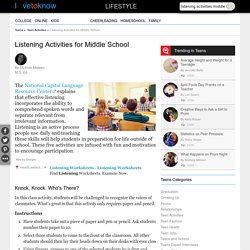
Listening is an active process people use daily and teaching these skills will help students in preparation for life outside of school.
Top Speaking Games/ Activities! ESL. Speaking Activities for ESL: 10 Best Speaking Activities every Teacher should Know. Online Speaking Games for ESL Learners (So Easy and Fun!)
British Council - Teaching Speaking Techniques (John Kay)
PODCAST: An alternative way to improve EFL students’ listening and speaking performance. Abdous, M., Camarena, M. M., & Facer, B. R. (2009). MALL technology: Use of academic podcasting in the foreign language classroom.
Podcasting in Education: What Are the Benefits?
New technology always has a heavy impact on education, and podcasting is no different. Many learning institutions are cutting back on textbooks and investing in technology-enhanced learning. Podcasting, as one of the latest mediums to emerge into the mainstream, is one of the forefront technologies in this change. In this article, I'll show you how podcasting in education can increase accessibility and encourage engagement. Podcasting offers the opportunity for lecturers to easily broadcast engaging audio content, which students can then listen to at any time and wherever they are.
A student only needs to subscribe to a podcast feed and suddenly you can push educational content to them, rather than wait for them to come.
7 Great Podcasts that Can Improve Your ESL Teaching. ESL talk.










